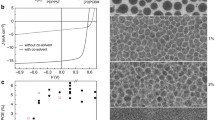Abstract
Control of phase separation length scales of polymers in a solution-processed film of binary (two-component) polymer blends is the most important step to realize significant photocharge generation and transport efficiencies leading to efficient solar cells. The dynamics of phase segregation becomes more complex in ternary (three-component) polymer blends. In the three-component blend, one component serves as sensitizer, and other two act as donor and acceptor polymer. The sensitizer absorbs photons and the energy is quickly transferred to the host donor. Subsequently, efficient charge transfer occurs at the host donor/acceptor interface. Depending on the relative amount of phase segregation between sensitizer/donor, sensitizer/acceptor and donor/acceptor, the different photophysical mechanisms (viz. energy transfer and charge transfer) are either boosted or suppressed. The correct kind of morphology should allow efficient energy transfer at the sensitizer/donor interface followed by efficient charge transfer at the donor/acceptor interface. We attempt to address these requirements by modulating the nanomorphology of a ternary blend via tailoring the non-solvent concentration in the ternary polymer blend solution. Here, we study the effect of non-solvent mixing and resultant film morphology is characterized by wide-field local photocurrent imaging and photoluminescence imaging in a confocal microscope set-up.


Similar content being viewed by others
References
Green MA, Emery K, Hishikawa Y, Warta W, Dunlop ED (2016) Solar cell efficiency tables (version 47). Prog Photovolt Res Appl 24:3–11
You J, Dou L, Yoshimura K, Kato T, Ohya K, Moriarty T, Emery K, Chen C-C, Gao J, Li G, Yang Y (2013) A polymer tandem solar cell with 10.6% power conversion efficiency. Nat Commun 4:1446
He Z, Zhong C, Su S, Xu M, Wu H, Cao Y (2012) Enhanced power-conversion efficiency in polymer solar cells using an inverted device structure. Nat Photonics 6:591
Dang MT, Hirsch L, Wantz G (2011) P3HT:PCBM, best seller in polymer photovoltaic research. Adv Mater 23:3597–3602
Li G, Shrotriya V, Huang J, Yao Y, Moriarty T, Emery K, Yang Y (2005) High-efficiency solution processable polymer photovoltaic cells by self-organization of polymer blends. Nat Mater 4:864–868
Wang T, Pearson AJ, Lidzey DG (2013) Correlating molecular morphology with optoelectronic function in solar cells based on low band-gap copolymer:fullerene blends. J Mater Chem C 1:7266–7293
Mukhopadhyay S, Das AJ, Narayan KS (2013) High-resolution photocurrent imaging of bulk heterojunction solar cells. J Phys Chem Lett 4:161
Mukhopadhyay S, Ramachandra S, Narayan KS (2011) Direct observation of charge generating regions and transport pathways in bulk heterojunction solar cells with asymmetric electrodes using near field photocurrent microscopy. J Phys Chem C 115:17184
Brenner TJK, McNeil CR (2011) Spatially resolved spectroscopic mapping of photocurrent and photoluminescence in polymer blend photovoltaic devices. J Phys Chem C 115:19364–19370
Lu L, Kelly MA, You W, Yu L (2015) Status and prospects for ternary organic photovoltaics. Nat Photonics 9:491–500
Ameri T, Khram P, Min J, Brabec CJ (2013) Organic ternary solar cells: a review. Adv Mater 25:4245–4266
Murali MG, Rao AD, Yadav S, Ramamurthy PC (2015) Narrow band gap conjugated polymer for improving the photovoltaic performance of P3HT:PCBM ternary blend bulk heterojunction solar cells. Polym Chem 6:962
Groves C (2013) Suppression of geminate charge recombination in organic photovoltaic devices with a cascaded energy heterojunction. Energy Environ Sci 6:1546–1551
Huang J-S, Goh T, Li X, Sfeir MY, Bielinski EA, Tomasulo S, Lee ML, Hazari N, Taylor AD (2013) Polymer bulk heterojunction solar cells employing Förster resonance energy transfer. Nat Photonics 7:479–485
Ameri T, Min J, Li N, Machui F, Baran D, Forster M, Schottler KJ, Dolfen D, Scherf U, Brabec CJ (2012) Performance enhancement of the P3HT/PCBM solar cells through nir sensitization using a small-bandgap polymer. Adv Energy Mater 2:1198–1202
Lu L, Chen W, Xu T, Yu L (2015) High-performance ternary blend polymer solar cells involving both energy transfer and hole relay processes. Nat Commun 6:7327
Benten H, Nishida T, Mori D, Xu H, Ohkita H, Ito S (2016) High-performance ternary blend all-polymer solar cells with complementary absorption bands from visible to near-infrared wavelengths. Energy Environ Sci 9:135–140
Bi P-Q, Wu B, Zheng F, Xu W-L, Yang X-Y, Feng L, Zhu F, Hao X-T (2016) An obvious improvement in the performance of ternary organic solar cells with “guest” donor present at the “host” donor/acceptor interface. ACS Appl Mater Interfaces 8:23212–23221
Gupta D, Kabra D, Kolishetty N, Ramakrishnan S, Narayan KS (2007) An efficient bulk-heterojunction photovoltaic cell based on energy transfer in graded-bandgap polymers. Adv Funct Mater 17:226–232
Padmanaban G, Nagesh K, Ramakrishnan S (2003) Segmented poly[2-methoxy-5- (2-ethylhexyloxy)-1,4-phenylene vinylene] via xanthate and dithiocarbamate precursors: a comparative study of thermal eliminations. J Polym Sci A Polym Chem 41:3929–3940
Padmanaban G, Ramakrishnan S (2004) Fluorescence spectroscopic studies of solvent- and temperature-induced conformational transition in segmented poly[2-methoxy-5-(2′-ethylhexyl)oxy-1,4-phenylenevinylene] (MEHPPV). J Phys Chem B 108:14933–14941
Nagesh K, Kabra D, Narayan KS, Ramakrishnan S (2005) Modulating phase- separation in blends of MEHPPV-x with different conjugation lengths. Synth Met 155:295–298
Candeias LP, Grozema FC, Padmanaban G, Ramakrishnan S, Siebbeles LDA, Warman JM (2003) Positive charge carriers on isolated chains of MEH−PPV with broken conjugation: optical absorption and mobility. J Phys Chem B 107:1554–1558
Acknowledgements
We thank Prof. S. Ramakrishnan from the Inorganic and Physical Chemistry Unit, Indian Institute of Science, Bangalore, for providing us MEHPPV polymers.
Author information
Authors and Affiliations
Corresponding author
Electronic supplementary material
Below is the link to the electronic supplementary material.
Supporting Information
Chemical Structure of Segmented MEHPPV-X and CNPPV, Photoluminescence and absorption spectra of Segmented MEHPPV, Schematic diagram of the ternary blend morphology and proposed near ideal blend morphology, Schematic depiction of collapsing of HC polymer chain upon non-solvent treatment, Scanning photocurrent microscopy setup. A representative current-voltage characteristics of a ternary blend device without any non-solvent. (DOCX 8568 kb)
Rights and permissions
About this article
Cite this article
Gupta, D., Nagesh, K., Narayan, K.S. et al. Photocurrent imaging of phase segregation in a ternary polymer blend induced via a non-solvent route. J Polym Res 24, 28 (2017). https://doi.org/10.1007/s10965-017-1187-6
Received:
Accepted:
Published:
DOI: https://doi.org/10.1007/s10965-017-1187-6




